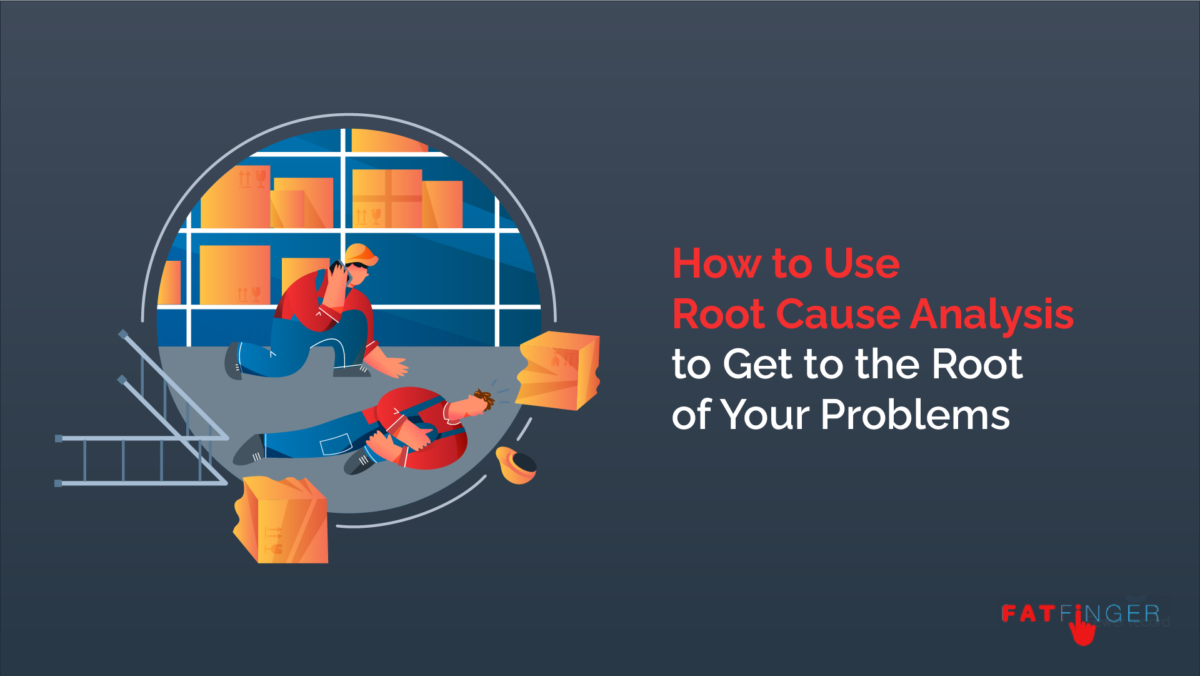In 2020, workplace accidents cost a whopping $163.9 billion. It’s a huge loss of time and productivity, not to mention the health risks involved. But what if you could prevent those accidents before they happen?
That’s where root cause analysis comes in.
Root cause analysis lets you get to the heart of your problems and let you lower the likelihood that they will happen again (or prevent them entirely). It’s a massive boon in the arsenal of anyone who wants to make sure that the mistakes of the past don’t keep repeating themselves.
However, root cause analysis isn’t the easiest thing to get started with. There’s no set framework to use, so if you don’t already have experience with analyzing and solving your problems, you might well struggle to get started.
FAT FINGER to the rescue!
In this post we’ll teach you everything you need to know about root cause analysis. You’ll learn everything from what it is and how to start identifying root causes to the best methods for carrying it out and how to supercharge your operations. We’ll cover:
- What is root cause analysis?
- The three types of root cause
- How to perform root cause analysis
- Supercharge your RCA
It’s time to wave goodbye to your problems.
What is root cause analysis?

Root cause analysis (RCA) is the practice of identifying the underlying cause of a problem. Thus, by getting to the heart of the issue, you can tackle the issue in a way which will prevent it from happening again.
Think of it like gardening.
A huge part of keeping your garden neat, tidy, and healthy is getting rid of any weeds that take hold where you don’t want them. Whether it’s crabgrass, thistles, or any other unwanted plant, it can spoil the view of your garden at best and take nutrients from or outright kill your other plants at worst.
You have two options.
You can cut or pull the visible section of the weed, which is quick to do and will superficially deal with the problem. However, this leaves the root of the weed in your garden, which will just grow into a full plant again. To prevent the issue from sprouting up again, you need to dig out the root of it.
Root cause analysis does this in a business context by identifying a problem, digging into why it has occurred (getting to the root of it) and figuring out a way to partially or (ideally) completely remove that cause. This prevents the problem from resurfacing later on, and ultimately helps your organization to succeed and stay healthy.
However, to remove the cause of your problems you must first understand them. So let’s get started!
The three types of root cause
There are three types of issues that can serve as the root cause of a problem:
- Physical
- Human
- Organizational
Physical

Physical causes are the result of an object or material thing failing or not working as intended. These are usually fairly easy to identify, as you should be able to visually see or observe the issue in question.
For example, if a car crashes and it’s found that the brakes weren’t working, the cause is physical. The object in question is the brakes, and their physical failure resulted in the crash. Similarly, a server could not be booting due to hardware issues, or a computer not functioning due to a short circuit.
The tricky part comes with analyzing this root cause to try and determine whether the physical cause occurred in isolation.
Going back to our car example, there is no way in which malfunctioning brakes could be written off as a cause. However, let’s say that the driver of the car knew about the condition of the brakes before ignoring the issue and driving anyway. In that case, the bigger root cause would be…
Human
Human root causes are issues that result from human action or inaction. The key here is that the person’s intention doesn’t matter – their contribution to the problem does.
So, our previous example of a car crash would have a physical cause (the brakes failing), but the root cause would be human due to the owner’s decision to ignore their faulty brakes.
Human causes can also include anything that occurs due to human error, as the problem was still ultimately caused by a person. Whether you typed something incorrectly and broke an important spreadsheet as a result or you filled your car with petrol instead of diesel, human error was still the root cause of your problem.
Organizational
Organizational causes muddy the water slightly, as these are issues which are based in policies and processes. Think of it as a failure of instructions – if your manual says to fill up your car with diesel, but it turns out that it only takes petrol, that’s an organizational error.
Think of all of the processes which have become outdated but you’re still required to carry out to satisfy management or health and safety. Consider every time that a team leader gave incorrect instructions to you due to their own incomplete or bad information. All of these are organizational causes.
How to perform root cause analysis
Root cause analysis can be a little daunting to start doing because there isn’t a singular “right” way to do it.
It isn’t like ISO 31000 with set guidelines to follow; RCA is a theory and goal to strive towards which can be achieved through the use of other techniques, but doesn’t have a central approved methodology itself.
That’s why we’re going to cover three of the best methods you can use to analyze the root causes of your problems:
- The 5 Whys
- FMEA
- Continuous improvement
The 5 Whys

Developed in the 1930s by Sakichi Toyoda (founder of Toyota industries), the 5 Whys technique is a simple method which is easy to get started using. This makes it perfect for anyone who has never performed root cause analysis before, as you don’t have to worry about learning a whole methodology along with analyzing the causes of your problems.
All you need to do is ask “why” 5 times.
Okay, so that might be a small exaggeration. There is some nuance in knowing when to push for further answers and when you’ve exhausted all useful avenues. The answers you get may also deserve separate follow-ups and highlight other solutions which could be put in place.
For example, say that an important spreadsheet with your company’s financial formulae in it has broken. It’s caused a huge mess and you want to get to the root cause of it.
- Why?
A formula malfunctioned and produced incorrect results, which fed into other formulae and broke those too. - Why?
Data was entered into the formula incorrectly - Why?
An EU employee subbed in for the usual US employee, and thus entered data incompatible with the other results (money is a different currency or a date in a different format) - Why?
The process they followed to fill out the spreadsheet didn’t account for a different employee filling out the data - Why?
The process wasn’t designed to be used by anyone other than the US employee
Here we can see that there was a physical cause (the formula breaking), a human cause (the human error of entering incorrectly formatted data), and an organizational cause (the process not giving nuanced enough instructions). However, we can also identify the root cause after our last “why”.
The root cause is that the organization’s processes (or at least this one) haven’t been designed with transparency in mind. They’re too specific on the assumed knowledge of the person carrying them out. So, when someone unexpectedly has to cover for, say, a sick or terminated employee, they won’t know how to carry out their tasks correctly.
FMEA
Failure Modes and Effects Analysis, or FMEA (and DFMEA) are another great option for performing root cause analysis.
FMEA focuses on finding the ways in which something can fail and assessing the effects of that failure. A large part of this is working out the scope of the problem and identifying the underlying causes of it. This then allows you to identify a suitable solution.
As you can see in the table above, FMEA is carried out by starting with a desired function or action. You then identify the potential ways (“failure modes”) in which that action could fail. Next you state the effects of this to show how important it is to succeed, and rank the severity of the issue if it happens (S).
Now you need to identify the root causes that could be triggering the problem. Bear in mind that you don’t have to settle on a single one for each failure mode.
Then move on to and rank how commonly the root cause is the issue (O). State what measures you have in place to detect each root cause, and rank how likely these are to warn you of the issue (D).
Finally, calculate the overall risk (SxOxD = RPN) and criticality (SxO = CRIT) of the issue.
Once you have all of this information you can prioritize which root cause to tackle first and think of actions you can take to further improve the situation. Then assign these actions to specific people to give them accountability, and take new measures for S, O, D, RPN, and CRIT. This lets you see whether those actions have helped the issue.
Continuous improvement
Continuous improvement is a simple concept – assess a process for improvements that can be made, then carry them out. Do this on a regular basis. This is why it’s so closely tied to Kaizen, change management, and many other industry-standard concepts and practices.
By continuously improving your organization you can remove the root causes of your problems, reduce waste, and improve performance across the board.
Much like root cause analysis, there’s also no set-in-stone method for carrying out continuous improvement. As long as you’re assessing and improving elements of your organization (particularly your processes) on a regular basis, you’ve got a continuous improvement program.
However, to give you a rough idea you can follow these steps:
- Map out a current process, including all tasks and elements of it
- Highlight accountable parties
- Identify bottlenecks, high-risk areas, and general problems
- List the causes and effects of these elements
- Suggest practical actions which could solve or limit these issues
- Implement your solution and measure the effects
- Repeat this set of actions for this process on a regular basis
That really is all there is to it!
Supercharge your RCA
In this post we’ve talked a lot about how human error contributes to problems, and how faulty processes can be the underlying cause of those errors. We’ve also stressed the importance of following a set process so that actions can be carried out effectively every time.
What if you didn’t have to worry about human or process errors anymore?
We here at FAT FINGER are dedicated to letting you overcome bad processes and achieve sustainable success. With our no-code form builder you can easily document your processes, letting you make sure that everything is performed correctly on time, every time.
Don’t have the time or expertise to build your own high-quality processes? No worries! Why not choose from our library of 100,000+ premade templates, which you can access and use completely for free!
Stop letting organizational causes be the root of your problems. Sign up for FAT FINGER today.


